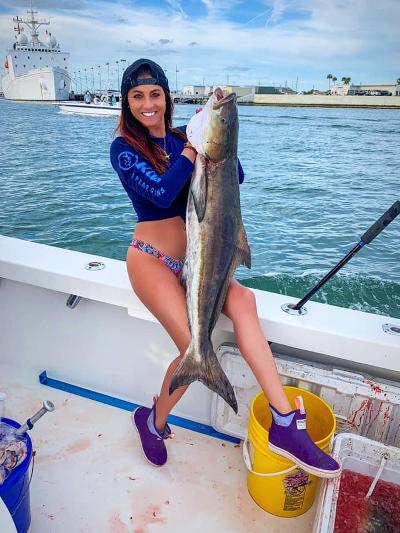The Cobia is a large, long, slim bodied fish with a broad depressed head, a protruding lower jaw. The Cobia is overall a dark brown color with a prominent dark lateral stripe that runs from the eye to the tail. Its distinguishing first dorsal fin is composed of 7 to 9 spines that are not connected by a membrane.
The Cobia is a sleek and extremely strong fish. They range in size up to about 135 pounds. The largest Cobia ever caught in Florida USA weighed about 104 lbs. An average size fish will weigh 20 to 40 pounds. Cobia are found around the world in tropic and warm temperate waters. They migrate so their numbers will very with the seasons. They inhabit the warm tropical waters in the winter and move to more temperate waters in the spring, summer and fall. They prefer water temperatures between 68 deg.F and 86 deg. F.
Along the Atlantic Coast of Florida, Cobia spend the winter (December – March) in the harbors and around the wrecks and reefs of the south Florida Keys. In late March, early April they begin their northward migration up the Atlantic Coast reaching Fernandina Inlet in late May, early June. Along the Gulf Coast, Cobia inhabit the Panhandle area in late February, early March. They travel southward along the coast beginning in April and peaking all along the Gulf Coast in July and August.
The Cobia is a powerful fish and a thrilling catch. It is one of the most sought after gamefish to catch. Once the fish is hooked the thrill usually begins by lots of line coming off a screaming reel and the inability of the angler to do anything but hang on!
Fishing Basics:Cobia can be caught by spinning, plug casting, bottom fishing and by trolling.
Equipment for spinning and plug casting should be a medium to medium heavy rod and reel with 12# to 20# line. Cast lures in front of moving fish so that the lure is reeled across the Cobia’s path. Brightly colored, jigs Bucktail (in white, lime green, yellow) and noisy sinking or diving plugs are popular choices
Equipment for trolling or bottom fishing from boat, bridge or pier would be a medium heavy rod and reel with 20#- to 30# line (Minimum 200yrds.) 2 – 4oz egg sinker on line above swivel, 3’ 40#-50# shock leader with a 4/0 to 7/0 O’Shaughnessy hook. Use live grunts, eels, pinfish, bluerunners or crabs as bait.
Site fishing migrating Cobia is one if the most productive methods for using artificial baits and lures. They are spotted as they travel in shallow water, around pilings, navigational markers, buoys and anchored boats. They will also accompany other large fish and rays. Again remember to cast ahead of the fish so to bring the lure across its path and to work the lure with plenty of action as the Cobia comes near.
Once you get the Cobia to the boat, the battle may not be over. Exhibit caution and safety when gaffing and bringing the fish into the boat. They are a tough hard fighting fish and have caused anglers to lose equipment, be injured and have damaged boats. Get the fish into the box in a controlled, smooth, single motion.
Food Quality
Cobia rates among the very best in taste and texture of seafood.
- Jay Mastry - March 26, 2024
- Captains Corner, Gorta - March 23, 2024
- Dave Zalewski - March 12, 2024











